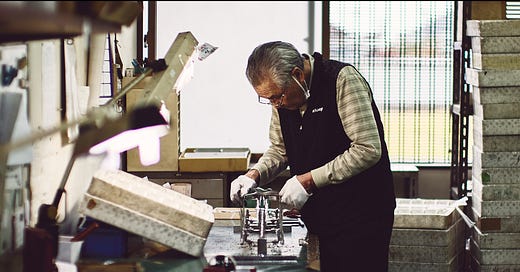What Japan Quality actually means, A case study ($)
some on the ground research and a story of Japanese craftsmanship
Disclaimer: The content on this website is for informational and educational purposes only. Nothing should be considered as investment advice or as a guarantee of profit. It may include some errors, please make sure to do your due diligence. The opinions expressed are those of the author and are subject to change without notice.
Like last time make sure to scroll all the way down for bonus content!
An intermission post before the logistics series Part 2 (Part 1 is here)
I was recently fortunate to be invited to a factory in rural Japan. To summarise my experience I’ll start with a quote from a book that gets quoted way too often by value investors these days (lol) but I feel resonated strongly.
“Quality is not a thing. It is an event. Warmer. It is the event at which the subject becomes aware of the object.” - Robert M. Pirsig
I think this was spot on.
What I saw, was just how much detail was put into each decision and process, intentionally forgoing advanced machinery in favor of human input in some cases. This is Japanese Craftsmanship, a fading art that I fear, will become harder and harder to find. I finally understood what it means to make things with soul. When I walked into their store the day after, I couldn’t unsee it.
Counterintuitively, this is precisely why some companies will be so hard to replicate, they harbor methods and practices that might not be found anywhere else. In an age of efficiency and productivity - should they be doing this? That’s ultimately up to the company’s strategy - and whether you want to grow through volume or price.
The other realization I had as a result, was “Oh if this is the strategy, their products should be priced much, much higher”.
So a little different content today than usual, but notes on some ‘on the ground’ research and a deeper understanding of the moat I found - the types of detail you simply wouldn’t be able to grasp through a filing. :) This might be my favorite piece I’ve written so far. These are the kinds of stories that represent why I’ve named this substack Made In Japan in the first place.



